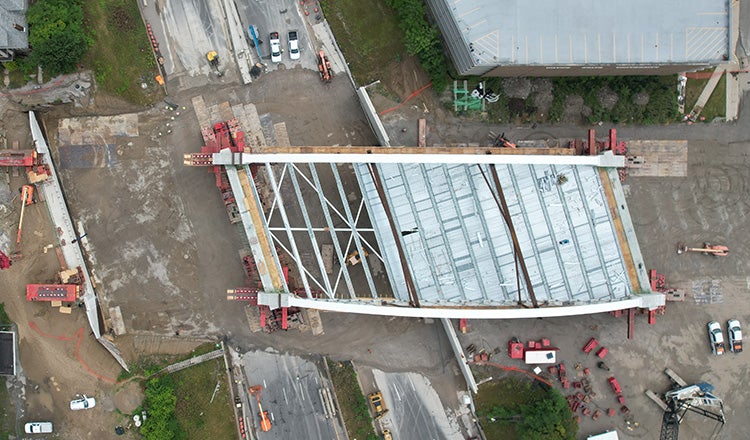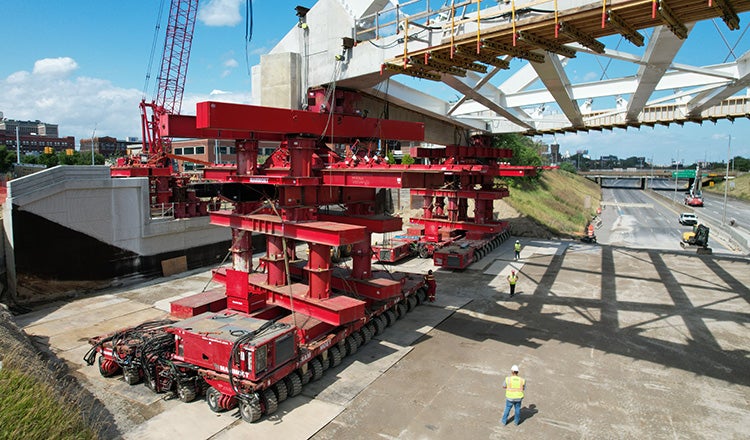Second Avenue Bridge Over I-94

Second Avenue Bridge Over I-94
Accelerated Bridge Construction and Unique Structure Design
The first skewed, unbraced network tied arch bridge in the United States crosses busy I-94 in Detroit. The Second Avenue Bridge, built with accelerated bridge construction methods, provides a complex and durable signature bridge to connect neighborhoods in the largest city in Michigan.
The Michigan Department of Transportation is undertaking a $2 billion multi-year modernization of I-94 through Detroit which includes replacing numerous aging and deteriorated bridges. Because of its condition the Second Avenue Bridge was prioritized for early replacement as part of the Advanced Bridges Program.
To link the Wayne State University main campus with the TechTown business park neighborhood, key stakeholders requested a unique and visually striking bridge to serve as a “community connector” structure. The resulting design is a wide structure, with an open view above the bridge and a park-like aesthetic, which is bike/pedestrian friendly with protective barriers and ornamental railings, energy-efficient LED aesthetic lighting and a raised median with extensive low-maintenance plantings.
Skew Fits the Site, but Complicates Fabrication and Construction
The replacement structure was designed to completely span the expanded future roadway of I-94 and the bridge footprint had to accommodate adjacent properties, most importantly a historic recording studio that produced the earliest origins of Detroit’s hallmark Motown music.
HDR designed the 245-foot-long, unbraced network tied arch span to be skewed 18 degrees in plan view to fit within this highly constrained footprint.

A skewed structure, especially when located on a vertical curve, complicates design and fabrication because none of the connection details are square and each component of the bridge is unique. Analysis of the bridge must consider the structural behavior during construction and in its finished state. Often the most vulnerable time in the life of a complex bridge is during construction, so the HDR design team, the owner’s independent engineer, and the contractor’s erection engineer worked closely together during construction to confirm that the independent design analyses agreed before construction could proceed.
MDOT requested a highly redundant structure that could resist the effects of the over-height vehicle strikes that are common in this portion of I-94. To meet this requirement, our team designed an innovative post-tensioned concrete tie girder system that is not only redundant and repairable, but also has a specific shape that helps deflect vehicle impacts, lessening their severity.
Contractor Outreach Set the Stage for Success
This section of I-94 carries nearly 150,000 vehicles per day and is adjacent to a major system-to-system-interchange with the Lodge Freeway (state highway M-10). MDOT needed a solution that minimized impacts on the motoring public through multiple traffic staging phases and the planned roadway alignment shift of the I-94 Modernization Project. Early project planning focused on an accelerated bridge construction approach whereby the bridge could be fabricated nearby and moved into place using self-propelled modular transporters, or SPMTs. The transporters — remote controlled and synchronized multi-axle hydraulic trailers — safely lift and move the bridge to its final location during a single freeway closure.

Early outreach to the specialty heavy lift construction industry was key to optimizing a bridge design well-tuned to this accelerated approach. The design team and MDOT conducted a series of confidential one-on-one meetings with suppliers of SPMT units to discuss how they would move this bridge into place. The only feasible location to assemble the bridge skeleton was a parking lot adjacent to the project site. However the parking lot was approximately 20 feet higher than the elevation of I-94, requiring a handoff of the bridge to SPMTs on the roadway below while moving the bridge into place.
To reduce the weight to be moved, the 2,600-ton bridge skeleton — the entire arch span without the deck — was lifted with the SPMTs, carried into place spanning the freeway, and lowered safely onto its abutments. After the skeleton move was completed and the 11-inch-thick concrete deck was cast and cured, temporary bracing members were removed, resulting in a unique unbraced arch span.
Following the successful move, traffic resumed on I-94 while finishing details of the bridge are completed. The $26 million bridge, on schedule to be opened to traffic in early 2023, is a first of its kind in Michigan, both as a network tied arch and for using SPMTs to install the bridge skeleton.











